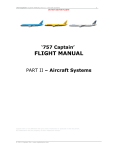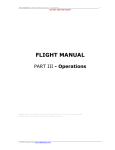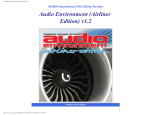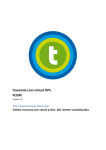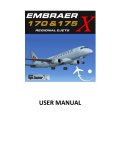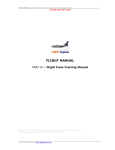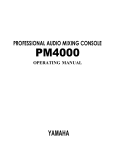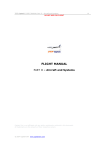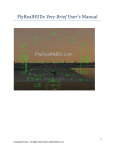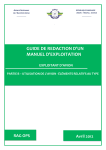Download Normal Procedures
Transcript
‘767 Captain’ Sim FLIGHT MANUAL Part III – Normal Procedures DO NOT USE FOR FLIGHT ‘767 Captain’ FLIGHT MANUAL PART III – Normal Procedures Captain Sim is not affiliated with any entity mentioned or pictured in this document. All trademarks are the property of their respective owners. © 2009 Captain Sim www.captainsim.com 1 ‘767 Captain’ Sim FLIGHT MANUAL Part III – Normal Procedures DO NOT USE FOR FLIGHT ABOUT THIS MANUAL VERSION: 23 JULY, 2009 WARNING: THIS MANUAL IS DESIGNED FOR MICROSOFT® FSX USE ONLY. DO NOT USE FOR FLIGHT. The ‘767 Captain’ FLIGHT MANUAL is organized into five Parts: Each Part is provided as a separate Acrobat® PDF document: Click START > Programs > Captain Sim > 767 Captain > • Part I – User’s Manual • Part II – Aircraft Systems • Part III – Normal Procedures - this document • Part IV – Flight Characteristics and Performance Data • Part V - Flight Management System. Adobe Acrobat® Reader Required FOR GENERAL INFORMATION ON THE ‘767 CAPTAIN’ PRODUCT PLEASE USE WWW.CAPTAINSIM.COM . THIS MANUAL PROVIDES ADDITIONAL INFORMATION ONLY, WHICH IS NOT AVAILABLE ON THE WEB SITE. © 2009 Captain Sim www.captainsim.com 2 ‘767 Captain’ Sim FLIGHT MANUAL Part III – Normal Procedures DO NOT USE FOR FLIGHT CONTENTS Page 4 4 4 4 4 4 5 5 5 5 5 5 OPERATING LIMITATIONS GENERAL AIRPLANE GENERAL OPERATIONAL LIMITATIONS NON-AFM OPERATIONAL INFORMATION AIRPLANE WEIGHT RESTRICTIONS AUTO FLIGHT ENGINE ENGINE FUEL SYSTEM REVERSE THRUST FLIGHT CONTROLS NAVIGATION 6 NORMAL PROCEDURES 6 6 6 8 9 INTRODUCTION GENERAL NORMAL PROCEDURES PREFLIGHT AND POSTFLIGHT AREAS OF RESPONSIBILITY AND PANEL FLOW PILOT FLYING AND PILOT NOT FLYING AREAS OF RESPONSIBILITY 10 10 10 15 17 AMPLIFIED PROCEDURES EXTERIOR INSPECTION PREFLIGHT PROCEDURE - FIRST OFFICER PREFLIGHT PROCEDURE - CAPTAIN BEFORE START PROCEDURE 20 20 20 21 21 22 22 22 22 23 23 24 24 25 25 NORMAL PROCEDURES - AMPLIFIED PROCEDURES ENGINE START PROCEDURE AFTER START PROCEDURE BEFORE TAKEOFF PROCEDURE TAKEOFF PROCEDURE CLIMB PROCEDURE CRUISE PROCEDURE DESCENT PROCEDURE APPROACH PROCEDURE LANDING PROCEDURE GO-AROUND PROCEDURE LANDING ROLL PROCEDURE AFTER LANDING PROCEDURE SHUTDOWN PROCEDURE SECURE PROCEDURE 26 26 767 CHECKLISTS NORMAL PROCEDURES 27 28 29 30 31 32 33 FLIGHT PATTERNS TAKEOFF ILS APPROACH INSTRUMENT APPROACH USING VNAV INSTRUMENT APPROACH USING V/S CIRCLING VISUAL TRAFFIC PATTERN 34 CUSTOMER SUPPORT © 2009 Captain Sim www.captainsim.com 3 ‘767 Captain’ Sim FLIGHT MANUAL Part III – Normal Procedures DO NOT USE FOR FLIGHT 4 OPERATING LIMITATIONS GENERAL This chapter contains Airplane Flight Manual (AFM) limitations and Boeing recommended operating limitations. Limitations that are obvious, shown on displays or placards, or incorporated within an operating procedure are not contained in this chapter. AIRPLANE GENERAL OPERATIONAL LIMITATIONS Runway slope ±2% Maximum Operating Altitude 43,100 feet pressure altitude Maximum Takeoff and Landing Altitude 8,400 feet pressure altitude Maximum Takeoff and Landing Tailwind Component 10 knots NON-AFM OPERATIONAL INFORMATION Note The following items are not AFM limitations, but are provided for flight crew information. Turbulent air penetration speed is: 290 KIAS/.78 Mach. The navigation and display system does not support operations at latitudes greater than 87° North or South. AIRPLANE WEIGHT RESTRICTIONS MAXIMUM WEIGHT LIMITATIONS Weights Pounds Maximum Taxi Weight (MTW) 413,000 Maximum Take Off Weight (MTOW) 412,000 Maximum Landing Weight (MLW) 320,000 Maximum Zero Fuel Weight (MZFW) 295,000 OTHER WEIGHT RESTRICTIONS Note These weights may be further restricted by field length limits, climb limits, tire speed limits, brake energy limits, obstacle clearance, or enroute and landing requirements. © 2009 Captain Sim www.captainsim.com ‘767 Captain’ Sim FLIGHT MANUAL Part III – Normal Procedures DO NOT USE FOR FLIGHT 5 AUTO FLIGHT After takeoff, the autopilot must not be engaged below 200 feet AGL. Use of aileron trim with the autopilot engaged is prohibited. Maximum allowable wind speeds when landing weather minima are predicated on autoland operations: Headwind 25 knots Crosswind 25 knots Tailwind 10 knots ENGINE Continuous ignition must be on (engine start selector in the CONT position) while operating in severe turbulence. Note Continuous ignition is automatically provided in icing conditions when engine anti-ice is on. Flight crew shall not blank engine vibration display during takeoff. ENGINE FUEL SYSTEM The maximum fuel temperature is 49° С (120° F). The minimum inflight fuel tank temperature is 3°C (5°F) above the freeze point of the fuel being used. The center tank may contain up to 2000 pounds of fuel with less than full main tanks provided center tank fuel weight plus actual zero fuel weight does not exceed the maximum zero fuel weight, and center of gravity limits are observed. REVERSE THRUST Reverse thrust is for ground use only. Backing the airplane with use of reverse thrust is prohibited. FLIGHT CONTROLS The maximum altitude for flap extension is 20,000 ft. NAVIGATION Do not operate under IFR or at night into airports north of 73° North or south of 60° South latitude whose navigation aids are referenced to magnetic north. © 2009 Captain Sim www.captainsim.com ‘767 Captain’ Sim FLIGHT MANUAL Part III – Normal Procedures DO NOT USE FOR FLIGHT 6 NORMAL PROCEDURES INTRODUCTION GENERAL This chapter contains Normal Procedures. It incorporates routine normal procedures and associated flight patterns. NORMAL PROCEDURES Normal procedures are used by the trained flight crew to ensure airplane condition is acceptable and that the flight deck is correctly configured for each phase of flight. These procedures assume all systems are operating normally and automated features are fully utilized. Procedures are performed from recall and follow a panel flow. These procedures are designed to minimize crew workload and are consistent with flight deck technology. If the correct indication is not observed during accomplishment of procedures, verify controls are positioned correctly. If necessary, check the appropriate circuit breaker(s) and test the related system light(s). Before engine start, lights or indications verify the systems' condition or configuration. Review the EICAS status display before engine start to determine if messages are displayed which may affect dispatch and require maintenance action or compliance with the Minimum Equipment List (MEL). After engine start, it is not necessary to check status messages as any message having an adverse effect on safe continuation of the flight, and requiring crew attention, will appear as an EICAS alert message (warning, caution, or advisory). EICAS alert messages are the primary means of alerting the flight crew to non-normal conditions or improper configuration. During engine start and prior to takeoff, any alert message requires accomplishment of the appropriate non-normal procedure. Upon completion of the procedure and prior to takeoff, the Dispatch Deviations Guide (DDG) should be consulted to determine if MEL relief is available. Exterior lighting, flight deck lighting, and personal comfort items (such as shoulder heaters) are systems assumed to have obvious procedural requirements and are not addressed in this section. Flight crew duties are organized in accordance with an area of responsibility concept. Each crewmember is assigned a flight deck area where the crewmember initiates actions for required procedures. The panel illustrations in this section describe each crewmember's area of responsibility for pre/post flight and phase-offlight. Pre/post flight duties are apportioned between the captain and first officer, while phase-of-flight duties are apportioned between the pilot flying (PF) and pilot not flying (PNF). A normal panel flow is encouraged; however, certain items may be handled in the most logical sequence for existing conditions. Actions outside the crewmember's area of responsibility are initiated at the direction of the captain. General phase-of-flight responsibilities are as follows: Pilot flying: • flight path and airspeed control • airplane configuration • navigation. Pilot not flying: • checklist reading • communications • tasks requested by PF • fuel shutoff and fire switches (with PF concurrence). Phase-of-flight duties, beginning with the takeoff procedure and ending with the landing roll procedure, are presented in table form in the appropriate procedures section. The first officer, when flying the airplane, performs the duties listed under pilot flying and the captain performs those duties listed under pilot not flying. Note: Although the mode control panel is designated as the pilot flying's responsibility, the pilot not flying should operate the controls on the mode control panel at the direction of the pilot flying when the airplane is being flown manually. © 2009 Captain Sim www.captainsim.com ‘767 Captain’ Sim FLIGHT MANUAL Part III – Normal Procedures DO NOT USE FOR FLIGHT 7 Autopilot Flight Director System and Flight Management System Monitoring When the autopilot, flight director, or autothrottle is in use and a mode change is selected or is scheduled to occur, the annunciation must be verified on the flight mode annunciation display. Airplane course, vertical path, and speed must always be monitored. Similarly, when a thrust reference mode change is selected or is scheduled to occur, the annunciation must be verified on the EICAS display. In LNAV and VNAV, all airplane course, vertical path, thrust, and speed changes must be verified. CDU Operation On the ground, the control display unit (CDU) manipulations are normally performed by the first officer and verified by the captain. In flight, CDU entries are accomplished by the pilot not flying and verified by the pilot flying prior to execution. CDU manipulations should be accomplished prior to high workload periods such as departure, arrival, or holding. During high workload periods, using autopilot modes such as heading select, flight level change, and the altitude and speed intervention features, along with the map switches, may be more efficient than entering complex route modifications into the CDU. © 2009 Captain Sim www.captainsim.com ‘767 Captain’ Sim FLIGHT MANUAL Part III – Normal Procedures DO NOT USE FOR FLIGHT PREFLIGHT AND POSTFLIGHT AREAS OF RESPONSIBILITY AND PANEL FLOW Audio Control Panel (ACP) and trim location may vary Captain First Officer LEGEND: Shaded area defines Captain's area of responsibility. Unshaded area is First Officer's responsibility. © 2009 Captain Sim www.captainsim.com 8 ‘767 Captain’ Sim FLIGHT MANUAL Part III – Normal Procedures DO NOT USE FOR FLIGHT PILOT FLYING AND PILOT NOT FLYING AREAS OF RESPONSIBILITY Weather Radar (WX) Audio Control Panel (ACP) and trim location may vary PF area of Responsibility PNF area of Responsibility Unshaded areas are the responsibility of the pilot seated on the respective side. Procedures Amplified © 2009 Captain Sim www.captainsim.com 9 ‘767 Captain’ Sim FLIGHT MANUAL Part III – Normal Procedures DO NOT USE FOR FLIGHT 10 AMPLIFIED PROCEDURES EXTERIOR INSPECTION Prior to each flight, a flight crewmember or the maintenance crew must verify the airplane is acceptable for flight. Check: • • • • • • • Flight control surfaces unobstructed and all surfaces clear of ice, snow, or frost. Door and access panels (not in use) properly secured. Ports and vents unobstructed. Airplane free of damage and fluid leakage. Wheel chocks in place, ground locking pins removed, and nose gear steering lever in normal position. Tire condition. Gear struts not fully compressed. PREFLIGHT PROCEDURE - FIRST OFFICER This procedure assumes the supplementary power up procedure has been accomplished and electrical power is established. The following procedures are accomplished in their entirety on each originating trip or crew change, or following maintenance action. Normally this procedure is accomplished by the First Officer. However, it does not preclude the captain from completing the procedure if time and conditions dictate. Maintenance documents ......................................................Check FLIGHT DECK ACCESS SYSTEM switch...................................NORM RESERVE BRAKES & STRG RESET/DISABLE guard...................Closed Verify ISLN light extinguished. Circuit breakers ..................................................................Check Emergency equipment.........................................................Check IRS mode selectors .............................................................OFF, then NAV Verify ALIGN lights illuminated. For all flights, a full alignment is recommended. YAW DAMPER switches ........................................................ON INOP lights remain illuminated until IRS alignment is complete. EEC switches......................................................................NORM HYDRAULIC panel ...............................................................Set LEFT and RIGHT ENGINE PRIMARY pump switches - ON Left and right engine pump PRESS lights remain illuminated until the respective engine is started. ELECTRIC PRIMARY pump switches - OFF DEMAND pump selectors - OFF HF radio ............................................................................Set BATTERY/STANDBY CONTROL panel......................................Set BATTERY switch - ON Verify DISCH light extinguished. STANDBY POWER selector - AUTO Verify standby power bus OFF light extinguished. © 2009 Captain Sim www.captainsim.com ‘767 Captain’ Sim FLIGHT MANUAL Part III – Normal Procedures DO NOT USE FOR FLIGHT 11 ELECTRICAL panel ..............................................................Set BUS TIE switches - AUTO Verify AC BUS OFF and utility bus OFF lights extinguished. APU GENERATOR switch - ON GENERATOR CONTROL switches - ON OFF and DRIVE lights remain illuminated until respective engine is started. APU selector.......................................................................START, then ON Position the APU selector back to the ON position. Do not allow the APU selector to spring back to the ON position. Lighting panel ....................................................................Set GLARESHIELD panel light controls - As desired AISLE STAND panel light controls - As desired LIGHT OVERRIDE switch - As desired RUNWAY TURNOFF light switches - OFF EMERGENCY LIGHTS switch .................................................ARMED Verify UNARMED light extinguished. PASSENGER OXYGEN ON light ..............................................Extinguished CAUTION: Switch activation causes deployment of passenger oxygen masks. RAM AIR TURBINE UNLKD light.............................................Extinguished WARNING: Switch activation may cause deployment of the ram air turbine. ENGINE CONTROL panel ......................................................Set Engine ignition selector - 1 or 2 Engine start selectors - AUTO FUEL JETTISON panel ..........................................................Set NOZZLE switches - OFF Selector-OFF FUEL panel.........................................................................Set CROSSFEED switches - OFF Verify VALVE lights extinguished. FUEL PUMP switches - OFF Left and right pump PRESS lights are illuminated. Left forward pump PRESS light is extinguished if the APU is running. Both center pump PRESS lights are extinguished. ANTI-ICE panel...................................................................Set WING anti-ice switch - OFF ENGINE anti-ice switches - OFF WIPER selector ...................................................................OFF Lighting panel ....................................................................Set POSITION light switch - As required RED and WHITE ANTI-COLLISION light switches - OFF WING light switch - OFF LANDING light switches - OFF WINDOW HEAT switches......................................................ON Verify INOP lights extinguished. HF radio ............................................................................Set PASSENGER SIGNS panel ....................................................Set NO SMOKING selector - AUTO or ON SEATBELTS selector - AUTO or ON CABIN ALTITUDE CONTROL panel .........................................Set © 2009 Captain Sim www.captainsim.com ‘767 Captain’ Sim FLIGHT MANUAL Part III – Normal Procedures DO NOT USE FOR FLIGHT AUTO RATE control - Index LANDING ALTITUDE selector - Destination airport elevation MODE SELECTOR - AUTO 1 or AUTO 2 EQUIPMENT COOLING mode selector ....................................AUTO Lighting panel ....................................................................Set CIRCUIT BREAKER panel light control - As desired OVERHEAD PANEL light control - As desired DOME LIGHT control - As desired LOGO light switch - As desired INDICATOR LIGHT selector - As desired BLEED AIR panel ................................................................Set ENGINE bleed air switches - ON Verify OFF lights illuminated. APU bleed air switch - ON Verify VALVE light extinguished. LEFT, CENTER and RIGHT ISOLATION switches - ON Verify VALVE lights extinguished. Air conditioning panel..........................................................Set PACK CONTROL selectors - AUTO Verify PACK OFF lights extinguished. FLIGHT DECK temperature control - AUTO Set as desired. Verify INOP lights extinguished. TRIM AIR switch - ON RECIRCULATION FAN switches - ON Verify INOP lights extinguished. CABIN temperature controls - AUTO Set as desired. Verify INOP lights extinguished. CARGO HEAT switches ........................................................ON Right VOR/DME switch.........................................................AUTO Right FLIGHT DIRECTOR switch ............................................ON EICAS display.....................................................................Check Secondary ENGINE DISPLAY switch - Push Indications - Normal. Verify: • primary and secondary engine indications display existing conditions • no exceedance values are displayed • oil quantity adequate for flight. STATUS DISPLAY switch - Push STATUS display - Verify: • hydraulic quantities do not display RF If any status message is displayed, refer to the Minimum Equipment List and Dispatch Deviation Guide to determine if dispatch relief is available. COMPUTER selector - AUTO Right CDU..........................................................................Set If MENU page displayed: FMC line select key - Push If IDENT page not displayed: INITREF key-Push INDEX line select key - Push IDENT line select key - Push IDENT page - Check Verify active date current. Verify Fuel Flow Factor is +1.7 or greater for PW4000 series engines. © 2009 Captain Sim www.captainsim.com 12 ‘767 Captain’ Sim FLIGHT MANUAL Part III – Normal Procedures DO NOT USE FOR FLIGHT 13 POS INIT line select key - Push Verify time correct. Inertial position - Enter Enter inertial position using the most accurate latitude and longitude. ROUTE line select key - Push Select company route or load route manually. ACTIVATE line select key - Push EXEC key-Push DEPARR key-Push Select runway and SID. ROUTE line select key - Push Verify SID and route are correct. EXEC key-Push Right EFIS control panel ......................................................Set Decision height selector - As desired TERRAIN switch - As desired HSI RANGE selector - As desired HSI TRAFFIC switch - As desired HSI mode selector - MAP HSI CENTER switch - As desired WEATHER RADAR switch - Off MAP switches - As desired WEATHER RADAR panel .......................................................Set Set panel - As desired Left VHF communications panel ............................................Set Center VHF communications panel ........................................Set Engine fire panel.................................................................Set ENG BTL 1 DISCH and ENG BTL 2 DISCH lights - Extinguished Engine fire switches - In Verify LEFT and RIGHT fire warning lights extinguished. ADF panel ..........................................................................Set Set panel - As desired Transponder panel ..............................................................Set ILS panel ...........................................................................Set Set panel - As desired CARGO FIRE panel ..............................................................Set CARGO FIRE ARM switches - Off Verify FWD and AFT fire warning lights extinguished. CARGO FIRE BTL DISCH light - Extinguished APU fire panel ....................................................................Set APU BTL DISCH light - Extinguished APU fire switch - In Verify APU fire warning light extinguished. Right VHP communications panel ..........................................Set First officer's audio control panel ..........................................Set Set panel - As desired Window 2 right ...................................................................Locked Verify the lock lever is in the locked (forward) position and the WINDOW NOT CLOSED decal is not in view. First officer's HEATERS ........................................................Set FOOT and SHOULDER switches - As desired © 2009 Captain Sim www.captainsim.com ‘767 Captain’ Sim FLIGHT MANUAL Part III – Normal Procedures DO NOT USE FOR FLIGHT First Officer's Lighting panel .................................................Set PANEL light control - As desired CHART light control - As desired FLOOD light control - As desired MAP light control - As desired Right INSTRUMENT SOURCE SELECT panel ............................Set FLIGHT DIRECTOR selector - R NAVIGATION SOURCE selector - FMC-R ALTERNATE SOURCE switches - Off Right flight instruments .......................................................Set Note: IRS alignment must be complete before AUTOLAND STATUS, VSI, ADI, HSI, and RDMI checks. ALTIMETER - Correct Set the local altimeter setting. Verify instrument indications are correct. Verify no flag displayed. VERTICAL SPEED INDICATOR - Correct Verify instrument indications are correct. Verify no flag displayed. Clock - Correct DATE switch - GMT ADI - Correct Flight mode annunciations - Verify: • autothrottle mode is blank • roll mode is TO • pitch mode is TO • AFDS status is F/D. Flight instrument indications are correct. Verify no flags displayed. HSI - Correct Verify Verify Verify Verify Route magnetic track correct. present heading correct. map mode displayed. no flags displayed. - Displayed, correct Airspeed indicator - Correct Verify instrument indications are correct. Verify no flag displayed. RDMI - Correct VOR/ADF switches - As desired. Verify instrument indications are correct. Verify no inappropriate flag displayed. AUTOLAND STATUS annunciator ...........................................Check Verify blank indications. HEADING REFERENCE switch................................................NORM or TRUE FLAP position indication and FLAP lever .................................Agree ALTERNATE FLAPS .............................................................Set ALTERNATE FLAPS selector - NORM ALTERNATE FLAPS switches - OFF Landing gear panel .............................................................Set Landing gear lever - DN ALTERNATE GEAR EXTEND switch - OFF (guarded position) © 2009 Captain Sim www.captainsim.com 14 ‘767 Captain’ Sim FLIGHT MANUAL Part III – Normal Procedures DO NOT USE FOR FLIGHT 15 GROUND PROXIMITY FLAP OVERRIDE switch..........................Off GROUND PROXIMITY GEAR OVERRIDE switch.........................Off GROUND PROXIMITY TERRAIN OVERRIDE switch ....................Off Right seat ..........................................................................Adjust Position seat for optimum eye reference. WARNING: Do not place objects between the seat and the aisle stand. Injury can occur when the seat is adjusted forward. Rudder Pedals ....................................................................Adjust Adjust to permit full rudder pedal and brake application. Right seat belt and shoulder harness.....................................Adjust Accomplish PREFLIGHT checklist on captain's command. PREFLIGHT PROCEDURE - CAPTAIN Normally, this procedure is accomplished by the captain. However, it does not preclude the first officer from completing the procedure if time and conditions dictate. Left VOR/DME switch...........................................................AUTO Mode control panel..............................................................Set Left FLIGHT DIRECTOR switch - ON AUTOTHROTTLE ARM switch - ARM BANK LIMIT selector - As desired Autopilot DISENGAGE bar - UP LeftCDU.............................................................................Set If MENU page displayed: FMC line select key - Push If IDENT page not displayed: INITREF key-Push INDEX line select key - Push IDENT line select key - Push IDENT page - Check Verify active date current. Verify Fuel Flow Factor is +1.7 or greater for PW4000 series engines. POS INIT line select key - Push Verify present position and time correct. ROUTE line select key - Push Verify: • flight number correct • route correct. Left EFIS control panel ........................................................Set Decision height selector - As desired TERRAIN switch - As desired HSI RANGE selector - As desired HSI TRAFFIC switch - As desired HSI mode selector - MAP HSI CENTER switch - As desired WEATHER RADAR switch - Off MAP switches - As desired SPEEDBRAKE lever..............................................................DOWN ALTERNATE STABILIZER TRIM switches .................................Neutral Reverse thrust levers ..........................................................Down © 2009 Captain Sim www.captainsim.com ‘767 Captain’ Sim FLIGHT MANUAL Part III – Normal Procedures DO NOT USE FOR FLIGHT 16 WARNING: Movement of the reverse thrust lever could result in operation of the engine thrust reverser. Thrust levers ......................................................................Closed Flap lever ..........................................................................Set Position lever to agree with flap position. Parking brake.....................................................................Set Verify PARK BRAKE light illuminated. STABILIZER TRIM cutout switches ........................................NORM (guarded position) FUEL CONTROL switches......................................................CUT OFF Captain's audio control panel................................................Set Set panel - As desired Window 2 left .....................................................................Locked Verify the lock lever is in the locked (forward) position and the WINDOW NOT CLOSED decal is not in view. Captain's HEATERS .............................................................Set FOOT and SHOULDER switches - As desired Captain's Lighting panel.......................................................Set PANEL light control - As desired CHART light control - As desired FLOOD light control - As desired MAP light control - As desired Left INSTRUMENT SOURCE SELECT panel ..............................Set FLIGHT DIRECTOR selector - L NAVIGATION SOURCE selector - FMC-L ALTERNATE SOURCE switches - Off Left flight instruments .........................................................Set Note: IRS alignment must be complete before AUTOLAND STATUS, VSI, ADI, HSI, and RDMI checks. Airspeed indicator - Correct Verify instrument indications are correct. Verify no flag displayed. RDMI - Correct VOR/ADF switches - As desired. Verify instrument indications are correct. Verify no inappropriate flag displayed. ADI - Correct Flight mode annunciations - Verify: •..autothrottle mode is blank •..roll mode is TO •..pitch mode is TO •..AFDS status is F/D. Flight instrument indications are correct. Verify no flags displayed. HSI - Correct Verify magnetic track correct. Verify present heading correct. Verify map mode displayed. Verify no flags displayed. Route - Displayed, correct ALTIMETER - Correct Set the local altimeter setting. Verify instrument indications are correct. Verify no flag displayed. VERTICAL SPEED INDICATOR - Correct Verify instrument indications are correct. © 2009 Captain Sim www.captainsim.com 17 ‘767 Captain’ Sim FLIGHT MANUAL Part III – Normal Procedures DO NOT USE FOR FLIGHT Verify no flag displayed. Clock - Correct DATE switch - GMT AUTOLAND STATUS annunciator ...........................................Check Verify blank indications. RESERVE BRAKES AND STEERING switch...............................OFF Verify VALVE light extinguished. Standby instruments ...........................................................Check Standby ADI - Check ILS selector-OFF Verify no flags displayed. Airspeed indicator - Check Verify instrument indications are correct. Altimeter - Set Set local altimeter setting. Verify instrument indications are correct. Standby engine indicator selector .........................................AUTO AUTO BRAKES selector ........................................................OFF Left seat ............................................................................Adjust Position seat for optimum eye reference. WARNING: Do not place objects between the seat and the aisle stand. Injury can occur when the seat is adjusted forward. Rudder pedals ....................................................................Adjust Adjust to permit full rudder pedal and brake application. Left seat belt and shoulder harness.......................................Adjust BEFORE START PROCEDURE This procedure is accomplished after papers are on board and flight crew is ready for push back and/or engine start. Takeoff thrust reference ......................................................Set Verify correct thrust reference mode displayed. C, F/O CDU ..................................................................................Set INITREF key-Push Verify fuel quantities agree: • upload fuel quantity • fuel quantity indicator • CDU. Enter: • zero fuel weight • reserve fuel • cruise altitude • cost index. Check: • Step size TAKEOFF line select key - Push Enter: • takeoff flap setting. • CG • position shift value (if required). • wind (if required). • slope (if required). Check: • thrust line. • acceleration height. C,F/O © 2009 Captain Sim www.captainsim.com 18 ‘767 Captain’ Sim FLIGHT MANUAL Part III – Normal Procedures DO NOT USE FOR FLIGHT Verify PRE-FLT COMPLETE displayed CDU display-Set Usually one pilot on LEGS page and the other on CLB page. Note: If required for noise abatement reasons, enter a speed restriction, on the CLIMB page, of VREF 30 + 80 to 3,000 feet above field elevation. MCP ..................................................................................Set ........................ С IAS/MACH selector - Rotate Set V2 speed in the IAS/MACH window. Initial heading - Set Initial altitude - Set Airspeed bugs ....................................................................Set Set bugs at VI, VR, VREF 30 + 40, and VREF 30 + 80. C, F/O Start clearance ...................................................................Obtain C, F/O Obtain clearance to pressurize hydraulic systems and start engines. HYDRAULIC panel ...............................................................Set ........................ F/O Note: Pressurize right system first to prevent fluid transfer between systems. Right ELECTRIC DEMAND pump selector - AUTO Verify PRESS lights extinguished. C1 and C2 ELECTRIC PRIMARY pump switches - ON Verify C1 PRESS light extinguished. Center AIR DEMAND pump selector - AUTO Verify PRESS lights extinguished. Left ELECTRIC DEMAND pump selector - AUTO Verify PRESS lights extinguished. Note: C2 PRESS light will not be extinguished due to load shedding. Indication will be normal after engine start. FUEL panel.........................................................................Set ........................ F/O LEFT and RIGHT FUEL PUMP switches - ON Verify PRESS lights extinguished. If center tank contains fuel: CENTER FUEL PUMP switches - ON Note: Both PRESS lights will not be extinguished due to load shedding. Indications will be normal after engine start. RED ANTI-COLLISION light switch.........................................ON ........................ F/O PACK CONTROL selectors.....................................................OFF ....................... F/O Trim.................................................................................. ............................ Units, zero, zero Stabilizer trim -______UNITS Set for takeoff. Check in greenband. Aileron trim - ZERO Rudder trim-ZERO C, F/O Flight controls ....................................................................Check .................... С Displace control wheel and control column to full travel in both directions and verify: • freedom of movement • controls return to center • proper flight control movement on EICAS status display. Hold the nose wheel steering tiller during rudder check to prevent undesired nose wheel movement. Displace rudder pedals to full travel in both directions and verify: • freedom of movement © 2009 Captain Sim www.captainsim.com ‘767 Captain’ Sim FLIGHT MANUAL Part III – Normal Procedures DO NOT USE FOR FLIGHT • rudder pedals return to center • proper flight control movement on EICAS status display. Secondary ENGINE DISPLAY switch.......................................PUSH ..................... F/O Call for "BEFORE START CHECKLIST." ...................................С Accomplish BEFORE START checklist. ....................................F/O © 2009 Captain Sim www.captainsim.com 19 20 ‘767 Captain’ Sim FLIGHT MANUAL Part III – Normal Procedures DO NOT USE FOR FLIGHT NORMAL PROCEDURES - AMPLIFIED PROCEDURES ENGINE START PROCEDURE Captain Announce start sequence. First Officer Normal start sequence is right then left Call "START_____ENGINE." Position_____START selector to GROUND. Observe oil pressure increase Position_____FUEL CONTROL switch to RUN when: • at maximum motoring and a minimum of 15% N2 Observe initial EGT rise and EGT within limits. Abort start if EGT fails to rise within 20 seconds of selecting RUN or if EGT rising rapidly or approaching limit. Abort start if N1 fails to increase at EGT rise. Abort start if N2 fails to reach stabilized idle within 120 seconds of selecting RUN. Do not advance thrust beyond that required for taxi until 50°C oil temperature. Repeat procedure to start remaining engine. AFTER START PROCEDURE APU selector.......................................................................OFF ....................... F/O ENGINE ANTI-ICE switches ..................................................As required ............ F/O LEFT and RIGHT ISOLATION switches....................................OFF ....................... F/O PACK CONTROL selectors.....................................................AUTO..................... F/O RECALL .............................................................................Check .................... C, F/O If any message displayed refer to Minimum Equipment List and Dispatch Deviation Guide or airline equivalent to determine if dispatch relief is available. AUTO BRAKES selector ........................................................RTO....................... С Ground equipment ..............................................................Clear ..................... C, F/O Call for "AFTER START CHECKLIST."......................................С Accomplish AFTER START checklist. ......................................F/O © 2009 Captain Sim www.captainsim.com 21 ‘767 Captain’ Sim FLIGHT MANUAL Part III – Normal Procedures DO NOT USE FOR FLIGHT BEFORE TAKEOFF PROCEDURE Obtain taxi clearance ..........................................................F/O Brief taxi clearance .............................................................С Parking brake.....................................................................Release.................. С Call for "FLAPS __" as required for takeoff .............................С Position flap lever to takeoff setting. .....................................F/O Takeoff briefing ..................................................................Accomplish ............. С Flight attendants ................................................................Notify .................... F/O Call for "BEFORE TAKEOFF CHECKLIST." ................................С Accomplish BEFORE TAKEOFF checklist..................................F/O TAKEOFF PROCEDURE Pilot Flying Release brakes. Pilot Not Flying Position LEFT and RIGHT WING LANDING and WHITE ANTI-COLLISION light switches ON. Align airplane with runway. Position transponder mode selector to TA/RA. Advance thrust levers to approximately 1.10 EPR. Push THR switch. Verify correct takeoff thrust set. Monitor engine instruments throughout takeoff. Adjust takeoff thrust prior to 80 knots, if required. Note: After takeoff thrust is set, the captain's hand must be on the thrust levers until VI. Monitor airspeed. Monitor airspeed indications and call out any abnormalities. Verify 80 knots. Call "80 KNOTS." Verify V1 speed. Call "V1" Rotate at VR. At VR call "ROTATE." Establish a positive rate of climb. Monitor airspeed and vertical speed. Call for "GEAR UP" when positive rate of climb established. Call for "LNAV" when climb stabilized. Verify positive rate of climb then position landing gear lever UP. Push L NAV switch. Call for "VNAV" at flap retraction altitude. Push A/P ENGAGE COMMAND switch. Push VNAV switch. Call for "FLAPS_____" according to flap retraction schedule. Position flap lever as directed. Verify climb thrust set. Call for "AFTER TAKEOFF CHECKLIST." Position landing gear lever OFF after GEAR and DOORS lights extinguish. Accomplish AFTER TAKEOFF checklist. © 2009 Captain Sim www.captainsim.com 22 ‘767 Captain’ Sim FLIGHT MANUAL Part III – Normal Procedures DO NOT USE FOR FLIGHT CLIMB PROCEDURE Pilot Flying Pilot Not Flying Above 10,000 feet, position LANDING light switches OFF. At transition altitude, set altimeters to 29.92 in Hg (1013 mb). CRUISE PROCEDURE Pilot Flying Pilot Not Flying When CTR L and CTR R FUEL PUMP messages are displayed, push CENTER FUEL PUMP switches OFF. DESCENT PROCEDURE Pilot Flying Pilot Not Flying Prior to top of descent, modify active route as required for arrival and approach. Verify pressurization set to landing altitude. Set DH as required for approach. Set DH, ADF, and ILS as required for approach. Review all alert messages. Recall and review all alert messages. Set airspeed reference bugs to VREF 30, VREF 30 + Set airspeed reference bugs to VREF 30, VREF 30 + 40 and VREF 30 + 80. 40 and VREF 30 + 80. Set AUTO BRAKES selector to desired brake setting. When cleared to descend, set clearance limit altitude on MCP. APPROACH PROCEDURE Pilot Flying Pilot Not Flying At transition level, set altimeters. Verify correct arrival and approach procedures selected. Accomplish approach briefing. At 10,000 feet, position LEFT and RIGHT WING LANDING light switches ON. Call for "APPROACH CHECKLIST." © 2009 Captain Sim www.captainsim.com Accomplish APPROACH checklist. 23 ‘767 Captain’ Sim FLIGHT MANUAL Part III – Normal Procedures DO NOT USE FOR FLIGHT LANDING PROCEDURE Pilot Flying Pilot Not Flying Notify flight attendants. Call for "FLAPS __" according to flap extension schedule. Position flap lever as directed. When on localizer intercept heading, verify ILS tuned and identified and localizer and glideslope pointers displayed, arm APP mode. At glideslope alive, call for: Position landing gear lever DN. "GEAR DOWN" "FLAPS 20." Position flap lever to 20. Position speedbrake lever to ARM. At glideslope capture, call for "FLAPS ___ " as required for landing. Position flap lever as commanded. Set missed approach altitude on MCP. At final approach fix/OM, verify crossing altitude. Call for "LANDING CHECKLIST." Accomplish LANDING checklist. Monitor approach progress. Verify Autoland status at 500 feet radio altitude. GO-AROUND PROCEDURE Pilot Flying Push go-around switch. Pilot Not Flying Position flap lever to 20. Call for "FLAPS 20." Verify rotation to go-around attitude and thrust increase. Verify thrust adequate for go-around; adjust if necessary. After positive rate of climb established, call for "GEAR UP." Verify positive rate of climb then position landing gear lever UP. Above 400 feet radio altitude, select LNAV or HDG SEL. At flap retraction altitude, set speed to VREF 30 + 80. Push CLIMB thrust reference mode select switch. Call for "CLIMB THRUST." Call for "FLAPS ____ " according to flap retraction schedule. Position flap lever as directed. After flap retraction, select FLCH or VNAV as required. Verify missed approach route being tracked and missed approach altitude captured. Call for "AFTER TAKEOFF CHECKLIST." Position landing gear lever OFF after GEAR and DOORS lights extinguish. Accomplish AFTER TAKEOFF checklist. © 2009 Captain Sim www.captainsim.com 24 ‘767 Captain’ Sim FLIGHT MANUAL Part III – Normal Procedures DO NOT USE FOR FLIGHT LANDING ROLL PROCEDURE Pilot Flying Pilot Not Flying Monitor rollout progress and proper auto brakes operation. Verify thrust levers closed and speedbrake lever up. Verify speedbrake lever UP and call "SPEEDBRAKES UP." If speedbrake lever not UP, Without delay, raise reverse thrust levers to the call "SPEEDBRAKES NOT UP." interlocks, hold light pressure until release, and then apply reverse thrust as required. By 60 knots, initiate movement of reverse thrust levers to reach reverse idle detent prior to taxi speed. Call "60 KNOTS." Position levers full down (forward thrust) when engines have decelerated to reverse idle. Prior to taxi speed, disarm the auto brakes and continue manual braking as required. Disconnect autopilot prior to runway turnoff. WARNING After reverse thrust is initiated, a full stop landing must be made. AFTER LANDING PROCEDURE Accomplished when clear of the active runway. APU selector.......................................................................START, then ON ...... F/O Position the APU selector back to the ON position. Do not allow the APU selector to spring back to the ON position. Exterior lights.....................................................................Set ........................ F/O Position WHITE ANTI-COLLISION light switch OFF and LANDING/TAXI light switches as required. Speedbrake lever................................................................DOWN ................... С Weather radar ....................................................................Off ........................ C,F/O AUTO BRAKES selector ........................................................OFF ....................... F/O Flaps .................................................................................UP......................... F/O Transponder.......................................................................Off ........................ F/O © 2009 Captain Sim www.captainsim.com 25 ‘767 Captain’ Sim FLIGHT MANUAL Part III – Normal Procedures DO NOT USE FOR FLIGHT SHUTDOWN PROCEDURE Parking brake.....................................................................Set ........................ С Verify PARK BRAKE light illuminated. Electrical power ..................................................................Establish ................ F/O If APU power is required: Check APU RUN light is illuminated. If external power is desired: EXTERNAL POWER AVAIL light - Illuminated EXTERNAL POWER switch - Push ENGINE ANTI-ICE switches ..................................................OFF ....................... F/O FUEL CONTROL switches......................................................CUT OFF ................ С Verify ENG VALVE and SPAR VALVE lights extinguished. Parking brake ....................................................................Release.................. С When wheel chocks in place, release the parking brake. SEATBELTS selector ............................................................OFF ....................... F/O HYDRAULIC panel ...............................................................Set ........................ F/O Note: Depressurize right system last to prevent fluid transfer between systems. Left ELECTRIC DEMAND pump selector - OFF C1 and C2 ELECTRIC PRIMARY pump switches - OFF Center AIR DEMAND pump selector - OFF Right ELECTRIC DEMAND pump selector - OFF FUEL PUMP switches............................................................OFF ....................... F/O RED ANTI-COLLISION light switch.........................................OFF ....................... F/O LEFT and RIGHT ISOLATION switches....................................ON ........................ F/O FLIGHT DIRECTOR switches .................................................OFF C, F/O Status messages ................................................................Check .................... F/O APU selector.......................................................................Set ........................ F/O If APU power is no longer required: APU selector-OFF Call for "SHUTDOWN CHECKLIST."........................................С Accomplish SHUTDOWN checklist..........................................F/O SECURE PROCEDURE IRS mode selectors .............................................................OFF ....................... F/O EMERGENCY LIGHTS switch .................................................OFF ....................... F/O WINDOW HEAT switches......................................................OFF ....................... F/O CARGO HEAT switches.........................................................OFF ....................... F/O PACK CONTROL selectors.....................................................OFF ....................... F/O Call for "SECURE CHECKLIST." .............................................С Accomplish SECURE checklist. ..............................................F/O © 2009 Captain Sim www.captainsim.com 26 ‘767 Captain’ Sim FLIGHT MANUAL Part III – Normal Procedures DO NOT USE FOR FLIGHT 767 CHECKLISTS NORMAL PROCEDURES PREFLIGHT 1 3 4 5 OXYGEN FLIGHT INSTRUMENTS PARKING BRAKES FUEL CONTROL SWITCHES TESTED, 100% HEADING___, ALTIMETER___ SET CUTOFF BEFORE START 1 2 3 4 5 6 7 8 9 FLIGHT DECK DOOR PASSENGER SIGNS WINDOWS MCP TAKEOFF SPEEDS CDU PREFLIGHT TRIM TAXI AND TAKEOFF BRIEFING RED ANTI COLLISION LIGHT CLOSED AND LOCKED ___ LOCKED V2___, HDG___, ALT___ V1___, VR___, V2___ COMPLETED _____UNITS, ZERO, ZERO COMPLETED ON BEFORE TAXI 1 2 3 4 5 ANTI-ICE L and R ISOLATION SWITCHES RECALL AUTOBRAKE GROUND EQUIPMENT _____ OFF CHECKED RTO CLEAR BEFORE TAKEOFF 1 FLAPS _____ AFTER TAKEOFF 1 2 LANDING GEAR FLAPS UP and OFF UP DECSENT 1 2 3 4 5 PRESSURIZATION RECALL AUTOBRAKE LANDING DATA APPROACH BRIEFING LDG ALT CHECKED ___ VREF___, MINIMUMS___ COMPLETED APPROACH 1 ALTIMETERS SET LANDING 1 2 3 SPEEDBRAKE LANDING GEAR FLAPS © 2009 Captain Sim www.captainsim.com ARMED DOWN _____ 27 ‘767 Captain’ Sim FLIGHT MANUAL Part III – Normal Procedures DO NOT USE FOR FLIGHT SHUTDOWN 1 2 3 4 5 6 HYDRAULIC PANEL FUEL PUMPS FLAPS PARKING BRAKE FUEL CONTROL SWITCHES WEATHER RADAR SET OFF UP DOWN CUTOFF OFF SECURE 1 2 3 4 IRSs EMERGENCY LIGHTS SWITCH WINDOW HEAT PACK SWITCHES FLIGHT PATTERNS © 2009 Captain Sim www.captainsim.com OFF OFF OFF OFF 28 ‘767 Captain’ Sim FLIGHT MANUAL Part III – Normal Procedures DO NOT USE FOR FLIGHT Takeoff 3000 feet AGL • One or 2 engine climb speed Flap Retraction Schedule ________________________ Select next flap position when within 20 knots of the Maneuvering speed for that Position and accelerating • V2 +15 to V2+25 knots, 0r V2 to V2+15 knots (1 engine) • Accelerate and climb at VREF 30+80 knots • • Verify takeoff thrust set by 80 knots Monitor airspeed Flap up • • Thrust set • Manually advance thrust to stabilize • Engage autothrottle VR • Rotate © 2009 Captain Sim www.captainsim.com Climb stabilized • Select roll mode Positive rate of climb • Gear up Continuous thrust (1 engine) After Takeoff checklist Acceleration height Flap retraction altitude (normally 1000 feet) • Select pitch mode (2 engines) • Select V\ S 0 to + 200 fpm (1 engine) • Select \ verify climb thrust • Engage autopilot • Retract flaps on schedule 29 ‘767 Captain’ Sim FLIGHT MANUAL Part III – Normal Procedures DO NOT USE FOR FLIGHT ILS Approach On RADAR vectors • HDG SEL (AFDS) • Appropriate pitch mode (AFDS) Approaching intercept heading • Flaps 5 • • Flaps 1 Flaps 5 • • LNAV or appropriate roll mode (AFDS) VNAV or appropriate pitch mode (AFDS) Glideslope intercept • Landing flaps (2 engine) • Set missed approach altitude • Landing checklist Localizer capture • Final Approach Course heading Intercept Heading • ILS tuned and identified • LOC and G\S pointers displayed • Arm APP mode © 2009 Captain Sim www.captainsim.com Fix (LOM, MKR, DME) • Verify crossing altitude Glideslope alive • Gear down • Flap 20 (landing flaps for 1 engine) • Arm speedbrake Missed approach • Push GA switch (AFDS) • Flap 20 (flap 5 for 1 eng) • Go-around attitude • Go-around thrust • Positive rate of climb, gear up • Above 400 feet select roll mode (AFDS) • At flap retraction altitude, set speed for desired flap setting • Select climb thrust (2 engine) • Retract flaps on schedule • After flap retraction, select FLCH or VNAV as required • Select continuous thrust (1 engine) • Verify tracking route and altitude capture • After Takeoff checklist 30 ‘767 Captain’ Sim FLIGHT MANUAL Part III – Normal Procedures DO NOT USE FOR FLIGHT Instrument Approach Using VNAV On RADAR vectors • HDG SEL • Appropriate pitch mode Approaching intercept heading • Flaps 5 • • Flaps 5 Intercept Heading • Arm LNAV or appropriate roll mode Inbound (2NM) • Gear down • Flap 20 (landing flaps for 1 engine) • Arm speedbrake • Set DA(H) or MDA(H) • Select VNAV • Speed intervention • Landing flaps (2 engine) © 2009 Captain Sim www.captainsim.com Flaps 1 Descend to DA(H) or MDA(H) • Monitor VNAV path • Landing checklist At DA(H) or MDA(H) • Intercept landing profile and disengage autopilot and disconnect autothrottle Enroute to fix • LNAV or appropriate roll mode • VNAV or appropriate pitch mode Missed approach • Push GA switch • Flap 20 (flap 5 for 1 eng) • Go-around attitude • Go-around thrust • Positive rate of climb, gear up • Above 400 feet select roll mode • At flap retraction altitude, set speed for desired flap setting • Select CLB thrust (2 engine) • Retract flaps on schedule • After flap retraction, select FLCH or VNAV as required • Select CON thrust (1 engine) • Verify tracking route and altitude capture • After Takeoff checklist 31 ‘767 Captain’ Sim FLIGHT MANUAL Part III – Normal Procedures DO NOT USE FOR FLIGHT Instrument Approach Using V/S On RADAR vectors • HDG SEL • Appropriate pitch mode Approaching intercept heading • Flaps 5 • • Enroute to fix • LNAV or appropriate roll mode • VNAV or appropriate pitch mode Flaps 1 Flaps 5 Intercept Heading • Arm LNAV or appropriate roll mode Descend to MDA(H) • Set V/S • Landing checklist Approaching MDA(H) • Set missed approach altitude in MCP Inbound (2NM) • Gear down • Flap 20 (landing flaps for 1 engine) • Arm speedbrake • Set MDA(H) • Landing flaps (2 engine) © 2009 Captain Sim www.captainsim.com At MDA(H) • Intercept landing profile and disengage autopilot and disconnect autothrottle Missed approach • Push GA switch • Flap 20 (flap 5 for 1 engine) • Go-around attitude • Go-around thrust • Positive rate of climb, gear up • Above 400 feet select roll mode • At flap retraction altitude, set speed for desired flap setting • Select CLB thrust (2 engine) • Retract flaps on schedule • After flap retraction, select FLCH or VNAV as required • Select CON thrust (1 engine) • Verify tracking route and altitude capture • After Takeoff checklist 32 ‘767 Captain’ Sim FLIGHT MANUAL Part III – Normal Procedures DO NOT USE FOR FLIGHT Circling Minimum Descent Altitude • Select ALT HLD (if required) • Set missed approach altitude • Select HDG SEL Configuration at MDA(H) • Gear down • Flaps 20 (landing flaps for 1 engine) • Arm speedbrake Turning base • Landing flaps (if not previously selected) • Landing checklist Missed approach • Make climbing turn in the shortest direction toward the landing runway • Execute the missed approach Intercepting landing profile • Disconnect autopilot and autothrottle © 2009 Captain Sim www.captainsim.com 33 ‘767 Captain’ Sim FLIGHT MANUAL Part III – Normal Procedures DO NOT USE FOR FLIGHT Visual Traffic Pattern Entering downwind • Flap 5 Base • Landing flaps (2 engine) • Landing checklist 1500 FT 700-500 FT • Stabilized on profile Prior to turning base • Gear down • Flaps 20 (landing flaps for 1 engine) • Arm speedbrake • Start descent as required 2 NM 2 – 2 ½ NM © 2009 Captain Sim www.captainsim.com Go-around • Push GA switch • Go-around thrust • Go-around attitude • Flaps 20 (flap 5 for 1 engine) • Positive rate of climb, gear up • Retract flaps on schedule • After Takeoff checklist ‘767 Captain’ Sim FLIGHT MANUAL Part III – Normal Procedures CUSTOMER SUPPORT For Customer Support please visit: http://www.captainsim.com/support/ Thank you, Enjoy your flight! Captain Sim Team www.captainsim.com © 2008 Captain Sim www.captainsim.com 34



































